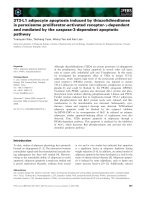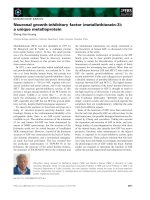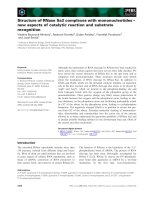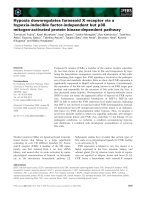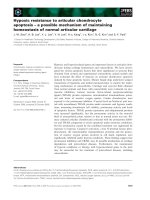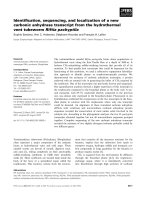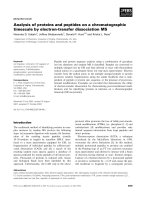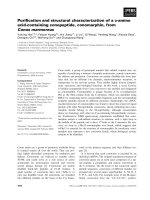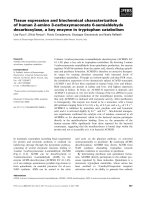Báo cáo khoa học: Do N-terminal nucleophile hydrolases indeed have a single amino acid catalytic center? Supporting amino acid residues at the active site of penicillin G acylase pptx
Bạn đang xem bản rút gọn của tài liệu. Xem và tải ngay bản đầy đủ của tài liệu tại đây (508.01 KB, 10 trang )
Do N-terminal nucleophile hydrolases indeed have
a single amino acid catalytic center?
Supporting amino acid residues at the active site of penicillin
G acylase
Diana Zhiryakova
1
, Ivaylo Ivanov
2
, Sonya Ilieva
3
, Maya Guncheva
1
, Boris Galunsky
4
and
Nicolina Stambolieva
1
1 Institute of Organic Chemistry with Center of Phytochemistry, Bulgarian Academy of Sciences, Sofia, Bulgaria
2 Faculty of Biology, University of Sofia ‘Sv. Kl. Ohridski’, Bulgaria
3 Faculty of Chemistry, University of Sofia ‘Sv. Kl. Ohridski’, Bulgaria
4 Institute of Technical Biocatalysis, Hamburg University of Technology, Germany
The N-terminal nucleophile (Ntn) hydrolase superfam-
ily comprises enzymes sharing a characteristic organi-
zation of the secondary structure in the catalytic
domain, despite the very low sequence homology [1,2].
The reaction mechanism that is suggested to be com-
mon for all Ntn hydrolases resembles that of serine
proteases, involving consecutive enzyme acylation and
deacylation steps. A feature of the catalytic mechanism
Keywords
catalytic mechanism; Hammett plot;
N-terminal nucleophile (Ntn) hydrolase;
penicillin G acylase; quantum mechanical
(QM) and molecular mechanical (MM)
modeling
Correspondence
D. Zhiryakova, Institute of Organic
Chemistry with Center of Phytochemistry,
Bulgarian Academy of Sciences, 9 Acad.
G. Bonchev str., 1113 Sofia, Bulgaria
Fax: +359 2 870 0225
Tel: +359 2 9606 160
E-mail:
(Received 25 September 2008, revised 28
January 2009, accepted 27 February 2009)
doi:10.1111/j.1742-4658.2009.06987.x
A new set of experimental kinetic data on the hydrolysis of a series of
phenylacetyl p-substituted anilides catalyzed by penicillin G acylase from
Escherichia coli (PGA) is presented in this article. The Hammett plot of
log(k
cat,R
⁄ k
cat,H
) versus r
p
)
has three linear segments, which distinguishes
the enzyme from the other N-terminal nucleophile hydrolases for which
data are available. Three amino acids in the vicinity of the catalytic SerB1
(AsnB241, AlaB69, and GlnB23) were included in the quantum mechanical
model. The stable structures and the transition states for acylation were
optimized by molecular mechanical modeling and at the AM1 level of the-
ory for three model substrates (with H, a methoxy group or a nitro group
in the para position in the leaving group). Intrinsic interactions of several
functional groups at the active site of PGA are discussed in relation to the
catalytic efficiency of the enzyme. The energy barrier computed for the first
step of acylation (the nucleophilic attack of SerB1) is lower than that for
the second step (the collapse of the tetrahedral intermediate). However, the
electronic properties of the substituent on the leaving group affect the
structure of the second transition state. It is shown that the main chain car-
bonyl group of GlnB23 forms a hydrogen bond with the leaving group
nitrogen, thus influencing the hydrolysis rate. On the basis of our computa-
tions, we propose an interpretation of the complex character of the Ham-
mett plot for the reaction catalyzed by PGA. We suggest a modified
scheme of the catalytic mechanism in which some of the intramolecular
interactions essential for catalysis are included.
Abbreviations
AE, acyl enzyme; AGA, aspartylglucosaminidase; ES, enzyme–substrate; GGT, c-glutamyl transpeptidase; MM, molecular mechanical;
Ntn, N-terminal nucleophile; PGA, penicillin G acylase from Escherichia coli; QM, quantum mechanical; TI, tetrahedral intermediate;
TS, transition state.
FEBS Journal 276 (2009) 2589–2598 ª 2009 The Authors Journal compilation ª 2009 FEBS 2589
of Ntn hydrolases is that the nucleophile (side chain
hydroxyl or thiol group), which attacks the carbonyl
carbon of the scissile amide bond, and the general
base, which accepts the proton from the nucleophile,
belong to the same N-terminal amino acid residue
(Ser, Thr, or Cys). The N-terminal nucleophile is
engaged in a hydrogen bond network, which has stabi-
lizing and activating functions in addition to maintain-
ing the proper spatial structure of the active site [3–5].
Therefore, the catalytic efficiency of Ntn hydrolases
strongly depends on intrinsic interactions within the
reaction intermediates. A deeper understanding of the
catalytic mechanism requires knowledge of the contri-
butions of the supporting, ‘catalytically insignificant’
amino acids to the energetics of the reaction.
The present article is focused on the hydrolytic reac-
tion catalyzed by penicillin G acylase from Escherichia
coli (PGA; EC 3.5.1.11). PGA is widely used for
hydrolytic and synthetic transformations in laboratory-
scale organic synthesis and in the industrial production
of semisynthetic b-lactam antibiotics [6–9]. The enzyme
is one member of the Ntn superfamily, which is struc-
turally very well characterized. Much information has
been accumulated from crystallographic and kinetic
studies, as well as from site-directed mutagenesis [10–
14]. The mature PGA is a periplasmic 86 kDa hetero-
dimer of A and B chains (209 and 557 amino acids,
respectively). The side chain hydroxyl of the N-termi-
nal SerB1 was identified as the attacking nucleophile.
Its specificity is determined mainly by the acyl moiety
of the substrate: phenylacetyl derivatives have the low-
est K
m
values. In contrast, the leaving group can
vary from ammonia to 6-aminopenicillanate through a
wide range of compounds with a primary amino or
hydroxyl group.
Here we present a new set of kinetic data on the
PGA-catalyzed hydrolysis of a series of phenylacetyl
p-substituted anilides (Scheme 1). For the interpreta-
tion of the experimental results, a quantum mechanical
(QM) model of the enzyme active site was constructed.
It illustrates the reorganization of the hydrogen bond
network at the active site, which predetermines the cat-
alytic transformations. Several functional groups in the
proximity of SerB1 were assigned probable roles in
catalysis.
Results and Discussion
The results of the kinetic experiments are presented in
Table 1. All substrates have Michaelis constants of the
same order of magnitude. This confirms an earlier con-
clusion, that the p -substituent on the leaving group
influences the reaction rate by its electronic properties
and does not affect substrate binding (Fig. S1) [15].
On the other hand, the hydrolysis rate varies with the
substituent on the amino moiety of the substrate, con-
firming that the formation of acyl enzyme (AE) is the
rate-limiting step of the reaction. The Hammett plot of
log(k
cat,R
⁄ k
cat,H
) versus r
p
)
is shown in Fig. 1. No cor-
relation was observed between the rate constant and
the van der Waals volume, the Taft steric parameter,
or the hydrophobic parameter of the substituent R.
The Brønsted plots of log( k
cat,R
⁄ k
cat,H
) versus pK
a,1
and pK
a,2
of the leaving aniline are given in Fig. S2.
The Hammett plot can be divided into three linear
segments: the points corresponding to substrates with
electron-donating substituents (R = CH
3
or OCH
3
) lie
on a line with a negative slope q = ) 2.95 ± 0.98; for
substrates with moderate electron-withdrawing substit-
uents (R = Br, CF
3
, COOC
2
H
5
or COCH
3
) the slope
is positive q = 0.90 ± 0.10; surprisingly, substrates
with R = CN or NO
2
lie on a line with a negative
slope q = )0.50 ± 0.18. The dependence of the rate
on the electronic factor of the substituent for the
PGA-catalyzed hydrolytic reaction is very distinct as
compared with the other Ntn hydrolases for which
data are available [16,17]. The Hammett plot of the
transpeptidation reaction catalyzed by c-glutamyl
transpeptidase (GGT; EC 2.3.2.2), is biphasic,
displaying a negative slope for the electron-donating
substituents (q = )1.3) and a positive slope for the
electron-withdrawing substituents (q = 0.4). The gly-
cosylasparaginase-catalyzed hydrolysis [aspartylgluco-
saminidase (AGA), EC 3.5.1.26] is also characterized
by a biphasic dependence: substrates with electron-
donating groups give a line with slope q = )0.94, and
substrates with electron-withdrawing groups give a line
with slope q = 0.70. For all three enzymatic reactions
(GGT-catalyzed transpeptidation, and AGA-catalyzed
and PGA-catalyzed hydrolysis), acylation is the rate-
limiting step [16–18]. However, the values of q for
Scheme 1. PGA-catalyzed hydrolysis of a series of phenylacetanilides.
Supporting amino acid residues at PGA active site D. Zhiryakova et al.
2590 FEBS Journal 276 (2009) 2589–2598 ª 2009 The Authors Journal compilation ª 2009 FEBS
PGA are higher than those reported for glycosylaspar-
aginase and GGT, indicating that the PGA-catalyzed
hydrolysis is much more sensitive to the electronic
properties of the substituent on the leaving group. The
third segment, corresponding to strong acceptor
groups on the leaving aniline of the substrate, repre-
sents a substantial difference and a key feature of the
PGA catalytic reaction. It is probably a cumulative
result of intrinsic amino acid interactions in the active
site of the E. coli enzyme that differentially (de)stabi-
lize the structures along the reaction pathway.
The interpretation of the presented kinetic results
requires a more sophisticated QM model that would
most adequately and yet economically reflect the inter-
actions at the PGA active site during catalysis. Three
residues in the vicinity of the N-terminal nucleophile
were selected for the construction of the model:
AsnB241, AlaB69, and GlnB23. AsnB241 proved to be
indispensable for catalysis, as its mutation to Ala led
to a dramatic reduction of the catalytic activity, with a
minor effect on proenzyme processing [11]. AsnB241,
together with the main chain amide of AlaB69, forms
the oxyanion hole that balances the negative charge
and thus lowers the energy of the reactive tetrahedral
intermediate (TI). In addition, it contributes to correct
positioning of the substrate against the catalytic SerB1.
GlnB23 was also shown to interact with the nucleo-
phile and the general base, and contribute to the
stabilization of the TI [5,10]. Table 2 presents data on
the interatomic distances in the crystal structures of
the wild-type enzyme, its complex with a competitive
Table 1. Kinetic parameters of the PGA-catalyzed hydrolysis of phenylacetyl p-substituted anilides. Values of r
p
)
are from [31]. pK
a,1
refers
to the equilibrium H
3
N
+
Ar ¡ H
2
NAr + H
+
;pK
a,2
refers to the second dissociation step, H
2
NAr ¡
)
HNAr + H
+
.
PhCH
2
CONHC
6
H
4
-pR
r
p
)
pK
a,1
pK
a,2
k
cat
(s
)1
) K
m
(mM)
k
cat
⁄ K
m
(mM
)1
Æs
)1
)Substituent R Name of substrate
NO
2
N-(4-Nitrophenyl)-2-phenylacetamide 1.27 1.02 18.9 16.7 ± 0.5 0.16 ± 0.01 104.4
CN N-(4-Cyanophenyl)-2-phenylacetamide 1.00 1.74 22.7 23.3 ± 1.1 0.52 ± 0.04 44.8
COCH
3
N-(4-Acetylphenyl)-2-phenylacetamide 0.84 2.19 22.6
a
27.4 ± 0.8 0.20 ± 0.01 137.0
COOC
2
H
5
Ethyl 4-[(phenylacetyl)amino]benzoate 0.75 2.38 21.6 ± 1.0 0.10 ± 0.01 216.0
CF
3
2-Phenyl-N-[4-(trifluoro-methyl)-phenyl]acetamide 0.65 2.57 24.3
a
17.7 ± 1.6 0.35 ± 0.09 50.6
Br N-(4-Bromophenyl)-2-phenylacetamide 0.25 3.88 26.0
a
7.5 ± 0.9 0.23 ± 0.04 32.6
H N,2-Diphenylacetamide 0.00 4.58 27.0 4.8 ± 0.4 0.14 ± 0.02 34.3
CH
3
N-(4-Methylphenyl)-2-phenylacetamide )0.17 5.07 5.1 ± 0.2 0.11 ± 0.01 46.4
OCH
3
N-(4-Methoxyphenyl)-2-phenylacetamide )0.26 5.30 9.4 ± 0.7 0.10 ± 0.02 94.0
a
For these substrates, pK
a2
values in water were not available. They were calculated from those for dimethylsulfoxide, using a linear correla-
tion [32].
–0.4 –0.2 0.0 0.2 0.4 0.6 0.8 1.0 1.2 1.4
–0.2
0.0
0.2
0.4
0.6
0.8
1
.
0
lg(k
cat,
R
/k
cat,
H
)
O
NH
R
–NO
2
–CN
–COCH
3
–COO
2
CH
5
–CF
3
–Br
–H
–OCH
3
–CH
3
σ
P
–
Fig. 1. Hammett plot for the hydrolysis of a series of phenylacetyl
p-substituted anilides catalyzed by PGA. The insert shows the
general formula of the substrates.
Table 2. Interatomic distances in the crystal structures of wild-type PGA and the complexes with phenylacetic acid, penicillin G sulfoxide
(PGSO), and its phenylmethanesulfonyl-serylB1 derivative.
Distance (A
˚
)
Ligand
Protein Data
Bank ID Reference
NaGlnB23
–OcSerB1
OeGlnB23
–NaSerB1
OdAsnB241
–NaSerB1
OaGlnB23
–ligand
2.89 3.18 3.01 1pnk [10]
2.89 3.18 3.01 3.86 (O ⁄ COO
)
) PhCH
2
COOH 1pnl [10]
2.69 2.97 2.89 3.60 (N ⁄ NH) PGSO 1gm9 [11]
2.68 3.26 2.86 3.39 (O ⁄ SO
2
) PhSO
2
-Oc
SerB1
1pnm [10]
D. Zhiryakova et al. Supporting amino acid residues at PGA active site
FEBS Journal 276 (2009) 2589–2598 ª 2009 The Authors Journal compilation ª 2009 FEBS 2591
inhibitor, the complex with a slowly hydrolyzed sub-
strate, and the phenylmethanesulfonyl-SerB1 deriva-
tive. These structures are mimics of the stationary
points along the reaction pathway; they depict the
changes in the spatial structure of the active site during
catalysis. Phenylacetic acid induces no essential change
in the conformation of the enzyme. Substrate binding
causes considerable shortening of the hydrogen bonds
of the side chain hydroxyl of SerB1 with the backbone
amino group of GlnB23 and with the side chain car-
bonyl group of AsnB241. The main chain carbonyl
group of GlnB23 closely interacts with the oxygen
atom in the locality of the nucleofuge in the structural
analog of the TI. These experimentally obtained
data form the basis for the construction of our
model, which is described in detail in Experimental
procedures.
The first stage of the catalytic cycle, enzyme acyla-
tion, proceeds via two steps separated by a relatively
stable intermediate, the TI. The structures of the
enzyme–substrate (ES) complex, AE with free aniline,
the TI, and two transition states (TSs) were optimized
for the model substrate CH
3
CONHC
6
H
5
in the envi-
ronment of the catalytic and the supporting amino
acids. Table 3 presents the geometry parameters, which
undergo significant changes during catalysis, optimized
by AM1 and HF ⁄ 6-31G** QM computations and
molecular mechanical (MM) modeling with the Dreid-
ing force field. The initial Michaelis complex (ES) fea-
tures spatial approximation of the side chain of SerB1
to the carbonyl carbon of the substrate, which is favor-
able for nucleophilic attack (Table 3 and Fig. S3). The
Michaelis complex of penicillin G with PGA has a
similar structure, and is shown in Fig. S4. In the TS
(TS1), which separates the ES complex from the TI,
the proton transfer from the nucleophile to the general
base is practically completed, and the bond between
Oc of SerB1 and the carbonyl carbon of the substrate
is partially formed. The positive charge of the a-amino
group of SerB1 in TS1 is stabilized by three hydrogen
bonds: two with the side chain carbonyl oxygens of
GlnB23 and AsnB241, and a bifurcate bond with its
own side chain oxygen and the carbonyl oxygen of the
substrate. The hydrogen bond between the negatively
charged Oc SerB1 and the main-chain NH of GlnB23
becomes stronger upon the nucleophilic attack. The
energy of the TI for acetanilide, estimated by AM1
computations, is 29.72 kcalÆmol
)1
relative to the energy
of the ES complex. Its optimized structure is shown in
Fig. 2. The interactions with the oxyanion-hole resi-
dues AsnB241 and AlaB69 strongly decrease the
energy of the TI. As our model shows, the oxyanion is
also hydrogen-bonded to the positively charged
a-amino group of SerB1, thus gaining additional sta-
bilization. The a-amino group of the aspartyl moiety
in b-N-acetylglucosaminyl-l-asparagine has a similar
function in the AGA-catalyzed hydrolysis [3]. Proba-
bly, such additional stabilization by a protonated
amino group in the proximity of the oxyanion can be
found in the rest of the Ntn hydrolases [3]. From
another point of view, the hydrogen bond between the
oxyanion and the aNH
3
+
of SerB1 resembles the one
between the carboxylate group of the Asp residue and
the protonated imidazole ring of the His residue in the
serine protease catalytic triad. In the second TS (TS2)
of the expulsion of the p-substituted aniline, the bond
between the oxyanion and the protonated a-amino
group of SerB1 is weaker than in TS1, allowing for
Table 3. Selected interatomic distances in the stationary points of the modeled PGA-catalyzed hydrolysis of acetanilide (R = H) and p-nitro-
acetanilide (R = NO
2
) optimized by AM1 calculations.
Atoms
a
Distance (A
˚
)
ES
R=H
TS1
R=H
TI
R=H
TI
b
R=H
TI
c
R=H
TS2
R=H
TS2
R=NO
2
AE + H
2
NC
6
H
5
R=H
N M C 1.38 1.43 1.50 1.47 1.45 1.57 (1.57) 1.95 (1.92) 2.87
Oc
SerB1
M C 3.37 1.84 1.50 1.49 1.51 1.48 (1.47) 1.42 (1.42) 1.37
N M H(Na
SerB1
) 3.52 3.04 2.60 2.95 2.23 1.36 (1.38) 1.71 (1.60) 1.00
N M Na
SerB1
3.62 4.05 3.06 3.74 2.89 2.62 (2.61) 2.76 (2.68) 3.24
Oc
SerB1
M Na
GlnB23
3.04 2.92 3.01 3.1 2.68 3.02 3.07 3.12
Na
SerB1
M Oe
GlnB23
4.36 2.92 2.85 2.88 3.00 3.00 2.90 3.04
Na
SerB1
M Od
AsnB241
3.01 2.78 2.73 2.79 2.74 2.98 (2.86) 2.81 (2.78) 3.20
Na
SerB1
M O 3.05 2.81 2.80 2.65 2.78 3.22 (2.94) 2.91 (2.85) 4.44
N M O(C=O)
GlnB23
3.02 3.21 3.24 3.28 2.59 3.20 3.23 3.21
Na
SerB1
M Oc
SerB1
2.97 2.80 2.94 2.85 2.86 2.97 (2.96) 2.97 (2.97) 2.94
a
If not designated otherwise, atoms belong to the former substrate.
b
From HF ⁄ 6-31G** QM calculations.
c
From MM calculations with the
Dreiding force field. Optimized geometry parameters without GlnB23 in the model are given in parentheses.
Supporting amino acid residues at PGA active site D. Zhiryakova et al.
2592 FEBS Journal 276 (2009) 2589–2598 ª 2009 The Authors Journal compilation ª 2009 FEBS
restoration of the carbonyl function. The hydrogen
bonds of a-NH
3
+
of SerB1 with OeGlnB23 and
OdAsnB241 are elongated. The protonated general
base is situated closer to the leaving group nitrogen
atom, and the proton transfer for the expulsion of the
aniline is in progress (general acid catalysis).
The untypical Hammett dependence observed for
the PGA-catalyzed hydrolysis of phenylacetyl anilides
indicates that a change in the reaction pathway or the
rate-limiting step occurs depending on the structure of
the substrate. For the model substrate acetanilide, the
energy barrier computed for the first step (the nucleo-
philic attack of SerB1), is 32.34 kcalÆmol
)1
, relative to
the energy of the ES complex. For the second step, the
barrier is 37.00 kcalÆmol
)1
, and this identifies the col-
lapse of the TI as the rate-limiting step of acylation.
This is also true for the nitro-substituted and methoxy-
substituted acetanilides, as well as for a different type
of substrate – N-methylacetamide. However, in the lat-
ter case, the two energy barriers are almost leveled, the
difference being only 2 kcalÆmol
)1
. The conclusions of
Menard et al. on the transpeptidation reaction cata-
lyzed by GGT are similar [16], as are the calculations
of Galabov et al. concerning the energetics of the alka-
line hydrolysis of N-phenylacetamides [19]. The investi-
gation of Perakyla et al. on the catalytic reaction of
AGA, however, predicts that, energetically, the highest
point in the acylation step is the nucleophilic attack on
the carbonyl carbon of the substrate [3]. Our result
disagrees with the conclusion of Chilov et al., who
employed a different model system [20]. The two mod-
els are in good agreement on the geometry of the sta-
tionary points on the potential energy surface of the
PGA-catalyzed hydrolysis. However, they disagree on
the energetics of the reaction, most probably because
of the substitution of the oxyanion hole with two
water molecules. The effective stabilization of the oxy-
anion is the main driving force of the first step of acyl-
ation, and dominates all other electronic effects on the
reaction center. The model system presented here more
closely reflects the structure and electron density distri-
bution of the real substrates and PGA active site.
In order to interpret the biphasic character of the
Hammett plots available for AGA and GGT, it was
suggested that the breakdown of the tetrahedral struc-
ture proceeded via general acid catalysis, whereby the
proton transfer to the nitrogen of the leaving group
aniline occurs simultaneously with the C–N bond
cleavage [17]. Accordingly, the degree of proton trans-
fer and C–N bond cleavage would both depend on the
electronic nature of the p-substituent [16]. Figure 3
shows the optimized structures of the second TSs of
the PGA-catalyzed hydrolysis of acetanilide (R = H)
and p-nitroacetanilide (R = NO
2
). As can be seen, the
stabilizing interactions of the oxyanion with AsnB241,
AlaB69 and the a-amino group of SerB1 become
weaker in TS2; the carbonyl group of the substrate is
partially restored, and the protonated general base is
properly oriented to give a proton to the leaving group
nitrogen (Table 2). In the case of R = H, the proton
transfer is 40% complete, whereas the amidic C–N
bond is cleaved to a very small degree. The TS resem-
bles the structure denoted TS2a in Fig. 4. The partial
positive charge on the nucleofuge nitrogen is stabilized
by hydrogen bonding with the main chain carbonyl
oxygen of GlnB23. Removing this residue from the
QM model results in practically no change in the struc-
ture of TS2. Energetically, its absence is partially com-
pensated for by a stronger interaction of the aNH
3
+
of SerB1 with the oxyanion and with the side chain of
AB
Fig. 2. Optimized structures of the TI of
hydrolysis of acetanilide by QM calculations
at the AM1 level (A) and of N,2-diphenyl-
acetamide by Dreiding force field MM
modeling (B).
D. Zhiryakova et al. Supporting amino acid residues at PGA active site
FEBS Journal 276 (2009) 2589–2598 ª 2009 The Authors Journal compilation ª 2009 FEBS 2593
AsnB241 (Table 3). The calculations show that TS2
for R = OMe does not differ substantially in structure
from that of acetanilide. However, as can be seen from
Fig. 4, GlnB23 makes a significant contribution to the
protonation of the leaving group prior to its expulsion.
The positive combination of the electronic factor of R
and the hydrogen bond between the leaving group
nitrogen atom and the main chain carbonyl oxygen of
GlnB23 is evidenced by the steep increase of hydrolysis
rate constant with the decrease of r
p
)
for the electron-
donating substituents (R = CH
3
or OCH
3
) (Fig. 1).
The second TS of acylation for p-nitroacetanilide
features a high degree of C–N bond cleavage and a
very low degree of protonation of the leaving group
(Fig. 4). The aromatic system provides resonance
stabilization of the partial negative charge on the
nitrogen. Electron-withdrawing substituents further
decrease the energy of the stationary point. Starting
from R = H with the increase in the r
p
)
value, TS2
shifts in the direction of TS2b, and the expulsion of an
anilide anion is more favored. The main chain car-
bonyl group of GlnB23 can still be hydrogen-bonded
to the leaving group nitrogen (Fig. 3). In the cases of
R = Br, CF
3
, COOC
2
H
5
or COCH
3
, the resultant
effect is a slow increase of the hydrolysis rate constant
with an increase in r
p
)
, i.e. a small value of q.In
comparison with the unsubstituted substrate, the
absence of GlnB23 in the QM model has a greater
AB
Fig. 3. Optimized structures of the second
TS of hydrolysis of acetanilides with (A)
R = H and (B) R = NO
2
in the para position
in the leaving group. The arrows on the TS
structures indicate the reaction coordinate
with an imaginary frequency.
N–H formation
C–N cleavage
CH
3
N H
3
+
O
H
NB n
R
O
–
TI
NH
2
R
CH
3
N H
2
O
Bn
O
H
2
N
O
H
N
+
Bn
R
O
–
H
TS2a
CH
3
N H
3
+
O
Bn
O
H
N
–
R
TS2b
AE
Fig. 4. More O’Ferrall diagram for the brea-
kdown of the TI of the PGA-catalyzed hydro-
lysis of CH
3
CONHC
6
H
4
-pR with GlnB23
(circles) and without GlnB23 (triangles) in
the constructed model. Solid symbols,
R = H; gray symbols, R = OMe; open
symbols, R = NO
2
.
Supporting amino acid residues at PGA active site D. Zhiryakova et al.
2594 FEBS Journal 276 (2009) 2589–2598 ª 2009 The Authors Journal compilation ª 2009 FEBS
effect on the structure of TS2 for p-nitroacetanilide.
The nucleofuge is protonated to a higher degree, and
the amidic C–N bond is a little shorter; the a-amino
group of SerB1 interacts closely with the oxyanion
(Fig. 3). This indicates that GlnB23 promotes the for-
mation of an anilide ion. Probably, the combination of
stronger resonance stabilization by the strong electron-
withdrawing groups (R = CN and NO
2
) and the
hydrogen bonding between the leaving group nitrogen
and the main chain carbonyl of GlnB23 leads to the
formation of a TS similar to TS2b. The subsequent
protonation of the nucleofuge becomes the rate-limit-
ing step of enzyme acylation. This is shown by the
negative slope of the third segment of the Hammett
plot for the strong electron acceptors.
The small difference between the hydrolysis rates of
esters and amides of common acyl moieties is evi-
dence for the effect of GlnB23 at the active site of
PGA on the energetics of the reaction. The values of
k
cat
for methyl 2-phenylacetate and 2-phenylacetamide
are 190 and 50 s
)1
, respectively. For both substrates,
acylation is rate-limiting, as the rate constant of deac-
ylation is over 1000 s
)1
[18]. For comparison, AGA
hydrolyzes the b-methyl ester of Asp faster than the
amide (Asn), the rate constants differing by several
orders of magnitude [21]. The leaving alcohol ⁄ alcox-
ide group cannot form a hydrogen bond with the
main chain carbonyl of GlnB23. Most probably, the
repulsion between the two oxygen atoms destabilizes
the second TS and leads to decreased catalytic effi-
ciency in ester hydrolysis. TyrB444 at the active site
of GGT (Protein Data Bank ID: 2dbx [22]) can inter-
act with the leaving group similarly to the main chain
carbonyl group of GlnB23 in PGA. However, this
Tyr residue can be both a donor and an acceptor of
a hydrogen bond. Such an interaction cannot be real-
ized at the active site of AGA, because no proper
functional group could be found within a 4 A
˚
radius
from the leaving group heteroatom (Protein Data
Bank ID: 1apz [23]).
GlnB23 plays critical role in the process of deacyla-
tion. The acyl acceptor (a water molecule) forms a
hydrogen bond with the main chain carbonyl oxygen
of GlnB23 [12]. This bond is present in the intermedi-
ate formed after the nucleophilic attack of the water
molecule. Its deprotonation by the a-amino group of
SerB1 is favored by stronger interaction of the general
base with the side chain oxygens of AsnB241 and
Scheme 2. Modified scheme of the cata-
lytic mechanism of the PGA-catalyzed
hydrolytic reaction.
D. Zhiryakova et al. Supporting amino acid residues at PGA active site
FEBS Journal 276 (2009) 2589–2598 ª 2009 The Authors Journal compilation ª 2009 FEBS 2595
GlnB23 (the basicity of aN of SerB1 is increased).
Thus TI
deac.
is formed, in which the oxyanion is stabi-
lized by the oxyanion hole residues and additionally by
the protonated a-amino group of SerB1. During the
breakdown of TI
deacyl.
, the increasing negative charge
of the leaving OcSerB1 is balanced by the main chain
NH of GlnB23.
On the basis of the presented kinetic results and the
QM model, we propose a modified scheme of the cata-
lytic mechanism of PGA, in which some of the intra-
molecular interactions essential for catalysis are
included (Scheme 2).
Conclusion
We present an experimental Hammett plot for the
PGA-catalyzed hydrolysis of a series of phenylacetyl
p-substituted anilides. The proposed interpretation of
its complex character is based on an extended QM
model, in which specific ES interactions are taken
into account. Several functional groups in the vicinity
of the catalytic center are assigned functions in catal-
ysis. The a-amino group of SerB1 and the main chain
NH of GlnB23 activate and stabilize the c-hydroxyl
group of SerB1 for nucleophilic attack on the sub-
strate. The protonated general base interacts with the
side chain carbonyl oxygens of GlnB23 and AsnB241,
and contributes to the stabilization of the oxyanion
in the TI. The main chain carbonyl group of GlnB23
forms a hydrogen bond with the leaving group nitro-
gen, thus influencing the hydrolysis rate. The specific
orientation and interaction of several amino acids at
the active site of PGA, combined with the effect of
the substituent on the geometry of the second TS,
leads to a change in the reaction pathway and the
rate-limiting step for the strong electron-withdrawing
substituents.
Experimental procedures
Organic solvents and initial arylamines were purchased
from Fluka (Darmstadt, Germany) and used without
further purification. PGA was purchased from Sigma
(St Louis, MO, USA).
PGA active site titration
Aliquots of the enzyme solution were incubated for a set
time with varying amounts of phenylmethanesulfonyl fluo-
ride (irreversible inhibitor of serine proteases) in 50 mm
sodium phosphate buffer (pH 7.0). An aliquot of every
sample was then used to catalyze the hydrolysis of a
constant amount of the chromogenic substrate 2-nitro-5-
phenylacetamidobenzoic acid at 25 °Cin50mm sodium
phosphate buffer (pH 7.0) containing 10% dimethylsulfox-
ide (v ⁄ v). The release of 5-amino-2-nitrobenzoic acid
allows the progress of the reaction to be followed spectro-
photometrically (k = 380 nm). The decrease of PGA
activity as a function of the amount of the inhibitor
was used to calculate the molar concentration of the
enzyme [24].
Synthesis of substrates for PGA
N-(4-methoxyphenyl)-2-phenylacetamide, N-(4-methylphenyl)-
2-phenylacetamide, ethyl 4-[(phenylacetyl)amino]benzoate,
N-(4-acetylphenyl)-2-phenylacetamide, N-(4-cyanophenyl)-2-
phenylacetamide and N-(4-nitrophenyl)-2-phenylacetamide
were obtained by the following procedure. One equivalent
of the p-substituted aniline and 1.1 equivalent amino base
(NEt
3
, N-methylmorpholine) were mixed in organic solvent
(tetrahydrofuran, chloroform) at 0 °C, and 1.2 equivalents
of phenylacetyl chloride were added dropwise. The mixture
was stirred at room temperature for 1–5 h. At the end of
the reaction, the hydrochloride of the organic base was fil-
tered. When chloroform was used, the reaction mixture was
washed consecutively with 0.1 m HCl, a saturated solution
of NaHCO
3
, and distilled water, and dried over MgSO
4
.
The organic solvent was evaporated, and the residue was
crystallized from ethanol, except for N-(4-cyanophenyl)-2-
phenylacetamide, which was crystallized from water, and
N-(4-nitrophenyl)-2-phenylacetamide, which was crystallized
from benzene. N,2-diphenylacetamide, N-(4-bromophenyl)-
2-phenylacetamide and 2-phenyl-N-[4-(trifluoromethyl)-
phenyl]acetamide were obtained by Schotten–Baumann
acylation: one equivalent of the p-substituted aniline was
dissolved in 10% aqueous NaOH; ethanol was added to
increase the solubility of the reagent. The mixture was
cooled to 0 °C, and 1.2 equivalents of phenylacetyl chloride
were added. The reaction mixture was stirred at room tem-
perature for 1–5 h. The precipitate was filtered, washed
with cold distilled water, and crystallized from EtOH (N,2-
diphenylacetamide was crystallized from methanol ⁄ water).
The purity of the synthesized substrates was confirmed
by means of elemental analysis,
1
H-NMR spectroscopy
(Bruker Avance DRX 250), and melting point determina-
tion (Bu
¨
chi B-540). The results were in good agreement
with those reported in the literature [15,25,26]. 2-Phenyl-N-
[4-(trifluoromethyl)-phenyl]acetamide (melting point 161–
162 °C) was newly synthesized. The results of the elemental
analysis were as follows for C
15
H
12
NOF
3
: calculated (%),
C – 64.51, H – 4.33, and N – 5.02; found (%), C – 64.61,
H – 4.38, and N – 4.97. Chemical shifts in the
1
H-NMR spectrum were as follows: d
H
, p.p.m. relative to
tetramethylsilane (dimethylsulfoxide-D
6
), 3.69 (2H, s,
C
6
H
4
CH
2
CO), 7.34–7.22 (5H, m, C
6
H
4
CH
2
CO), 7.66 (2H,
d, J = 8.5 Hz, NHC
6
H
4
CF
3
), 7.81 (2H, d, J = 8.5 Hz,
NHC
6
H
4
CF
3
), and 10.54 (1H, s, CONH).
Supporting amino acid residues at PGA active site D. Zhiryakova et al.
2596 FEBS Journal 276 (2009) 2589–2598 ª 2009 The Authors Journal compilation ª 2009 FEBS
PGA-catalyzed hydrolysis of the phenylacetyl
p-substituted anilides
Reactions were performed at 25 °C in 0.1 m sodium phos-
phate buffer (pH 7.0) containing 10% dimethylsulfoxide
(v ⁄ v). The total volume of the reaction mixture was
2000 lL. The initial substrate concentration ranged
from about 0.2 to 4.0 K
m
, with the exception of
N-(4-cyanophenyl)-2-phenylacetamide, N-(4-bromophenyl)-
2-phenylacetamide, and 2-phenyl-N-[4-(trifluoromethyl)-
phenyl]acetamide, in which cases the interval was narrower,
owing to limited solubility of the substrates in the reaction
mixture. The enzyme concentration was about three orders
of magnitude lower. The reaction was followed using a
Shimadzu UV-3000 UV–visible spectrophotometer at a
wavelength with maximum difference between substrate
and product molar absorption coefficients, as follows
[R (PhCH
2
CONHC
6
H
4
-pR) – k
detection
(nm)]: NO
2
– 416;
CN – 303; COCH
3
– 340; COOC
2
H
5
– 317; CF
3
– 260;
Br – 266; H – 260; CH
3
– 265; and OCH
3
– 265. Calibra-
tion curves for both the substrate and the free aniline were
prepared, and initial velocities were calculated, taking into
account both the consumption of the substrate and the lib-
eration of the arylamine with the time. The kinetic experi-
ments with each substrate concentration were performed in
triplicate. The turnover number and the Michaelis constant
were determined by nonlinear regression analysis.
Computational methods
The covalent complex of PGA with the irreversible inhibi-
tor phenylmethanesulfonyl fluoride was taken as an initial
structure (Protein Data Bank ID: 1pnm from the Research
Collaboratory for Structural Bioinformatics Protein Data
Bank, ). It was modified by the follow-
ing procedure, using the ds viewerpro 6.0 software pack-
age (Accelrys Software Inc., San Diego, CA, USA) (now
Discovery Studio: />studio/). The sulfur in the SO
2
group was replaced with a
carbon atom. One of the two oxygen atoms was trans-
formed into O
)
, and the other into nitrogen; thus, the two
double S = O bonds were replaced by C–O
)
and C–N
bonds. The leaving group – a phenyl residue – was then
added to the nitrogen atom. The resultant structure was the
TI of the hydrolysis of phenylacetyl anilide (R = H). This
enzymatic complex was then optimized by MM calculations
with the Drieding force field, using ds viewer [27]. All
atoms belonging to the protein moiety were fixed during
the optimization, except for SerB1 covalently bound to the
TI.
The model of the active center of PGA was then con-
structed using the optimized positions of the atoms of
SerB1, AlaB69, AsnB241, GlnB23 and the TI after substitu-
tion of the phenyl ring in the acyl moiety of the substrate
with a hydrogen atom. The spatial structure of the model
TI of acetanilide was optimized by AM1 QM computations
with the gaussian 98 software package [28].
Based on the structure of TI for acetanilide, the two TSs
of the nucleophilic attack of the side chain of SerB1 and
the collapse of TI were modeled. The stable structures and
the TSs were fully optimized at the AM1 level of theory
[28]. All stationary points were further characterized by
analytic computations of harmonic vibrational frequencies.
TSs were located using the synchronous transit-guided
quasi-Newton methods, implemented in gaussian [29].
Transition structures were checked by intrinsic reaction
coordinate calculations [30].
References
1 Brannigan JA, Dodson G, Duggleby HJ, Moody PCE,
Smith JL, Tomchick DR & Murzin AG (1995) A pro-
tein catalytic framework with an N-terminal nucleophile
is capable of self-activation. Nature 378, 416–419.
2 Dodson GG (2000) Catalysis in penicillin G amidase –
a member of the Ntn (N terminal nucleophile) hydro-
lase family. Croatica Chim Acta 73, 901–908.
3 Perakyla M & Kollman PA (1997) A simulation of the
catalytic mechanism of aspartylglucosaminidase using
ab initio quantum mechanics and molecular dynamics.
J Am Chem Soc 119, 1189–1196.
4 Liu Y, Guan C & Aronson NN (1998) Site-directed
mutagenesis of essential residues involved in the mecha-
nism of bacterial glycosylasparaginase. J Biol Chem
273, 9688–9694.
5 Oinonen C & Rouvinen J (2000) Structural comparison
of Ntn-hydrolases. Prot Sci 9, 2329–2337.
6 Arroyo M, de la Mata I, Acebal C & Castillon MP
(2003) Biotechnological applications of penicillin acylas-
es: state-of-the-art. Appl Microbiol Biotechnol 60, 507–
514.
7 Schoemaker HE, Boesten WHJ, Broxterman QB, Roos
EC, Kaptein B & van den Tweel WJJ (1997) Applica-
tion of enzymes in industrial organic synthesis. Chimia
51, 308–310.
8 Kadereit D & Waldmann H (2001) Enzymatic protect-
ing group techniques. Chem Rev 101, 3367–3396.
9 Waldmann H & Sebastian D (1994) Enzymatic protect-
ing group techniques. Chem Rev 94, 911–937.
10 Duggleby HJ, Tolley SP, Hill CP, Dodson EJ, Dodson
G & Moody PCE (1995) Penicillin acylase has a single-
amino-acid catalytic centre. Nature 373, 264–268.
11 McVey CE, Walsh MA, Dodson GG, Wilson KS &
Brannigan JA (2001) Crystal structures of penicillin
acylase enzyme–substrate complexes: structural insights
into the catalytic mechanism. J Mol Biol 313, 139–150.
12 Alkema WB, Hensgens CM, Kroezinga EH, de Vries E,
Floris R, van der Laan J-M, Dijkstra BW & Janssen
DB (2000) Characterization of the b-lactam binding site
of penicillin acylase from Escherichia coli by structural
D. Zhiryakova et al. Supporting amino acid residues at PGA active site
FEBS Journal 276 (2009) 2589–2598 ª 2009 The Authors Journal compilation ª 2009 FEBS 2597
and site-directed mutagenesis studies. Prot Eng 13, 857–
863.
13 Margolin AL, Svedas VK & Berezin IV (1980) Sub-
strate specificity of penicillin amidase from E. coli. Bio-
chim Biophys Acta 616, 283–289.
14 Cole M (1969) Hydrolysis of penicillins and related
compounds by the cell-bound penicillin acylase of Esc-
herichia coli. Biochem J 115, 733–739.
15 Guncheva M, Ivanov I, Galunsky B, Stambolieva N &
Kaneti J (2004) Kinetic studies and molecular modelling
attribute a crucial role in the specificity and stereoselec-
tivity of penicillin acylase to the pair ArgA145–
ArgB263. Eur J Biochem 271, 2272–2279.
16 Menard A, Castonguay R, Lherbet C, Rivard C, Rou-
pioz Y & Keillor JW (2001) Nonlinear free energy rela-
tionship in the general-acid-catalyzed acylation of rat
kidney c-glutamyl transpeptidase by a series of c-glut-
amyl anilide substrate analogues. Biochemistry 40,
12678–12685.
17 Du W & Risley JM (2003) Acylation is rate-limiting in
glucosylasparaginase-catalyzed hydrolysis of N
4
-(4¢-
substituted phenyl)-L-asparagines. Org Biomol Chem 1,
1900–1905.
18 Alkema WB, de Vries E, Floris R & Janssen DB (2003)
Kinetics of enzyme acylation and deacylation in the
penicillin acylase-catalyzed synthesis of b-lactam antibi-
otics. Eur J Biochem 270, 3675–3683.
19 Galabov B, Cheshmedzhieva D, Ilieva S & Hadjieva B
(2004) Computational study of the reactivity of
N-phenylacetamides in the alkaline hydrolysis reaction.
J Phys Chem A 108, 11457–11462.
20 Chilov GG, Sidorova AV & Svedas VK (2007) Quantum
chemical studies of the catalytic mechanism of
N-terminal nucleophile hydrolase. Biochemistry 72, 495–
500.
21 Risley J, Huang DH, Kaylor JJ, Malik JJ, Xia Y-Q &
York WM (2001) Glycosylasparaginase activity requires
the a-carboxyl group, but not the a-amino group, on
N
4
-(2-acetamido-2-deoxy-b-D-glucopyranosyl)-L-aspar-
agine. Arch Biochem Biophys 391, 165–170.
22 Okada T, Suzuki H, Wada K, Kumagai H & Fukuy-
ama K (2006) Crystal structures of gamma-glutamyl-
transpeptidase from Escherichia coli, a key enzyme in
glutathione metabolism, and its reaction intermediate.
Proc Natl Acad Sci USA 103, 6471–6476.
23 Oinonen C, Tikkanen R, Rouvinen J & Peltonen L
(1995) Three-dimensional structure of human lysosomal
aspartylglucosaminidase. Nat Struct Biol 2, 1102–1108.
24 Svedas VK, Margolin AL, Sherestyuk CF, Klyosov AA
& Berezin IV (1977) Phenylmethanesulfonylfluoride
inactivation of soluble and immobilized penicillin
amidase from E. coli. Kinetic analysis and titration
of active site. Bioorg Khim 3, 547–553.
25 Yamagami C, Takao N, Tanaka M, Horisaka K, Asada
S & Fujita T (1984) A quantitative structure–activity
study of anticonvulsant phenylacetanilides. Chem Pharm
Bull 32, 5003–5009.
26 Birnbaum LS & Powell G (1945) Amines related to epi-
nephrine. III. Amines of the eprocaine type. J Am Chem
Soc 67, 1464–1466.
27 Mayo SL, Olafson BD & Goddard WA (1990) DREID-
ING: a generic force field for molecular simulations.
J Phys Chem 94, 8897–8909.
28 Frisch MJ, Trucks GW, Schlegel HB, Scuseria GE,
Robb MA, Cheeseman JR, Zakrzewski VG, Montgom-
ery JA, Stratmann RE, Burant JC et al. (1998)
Gaussian 98 (Revision A.7). Gaussian, Inc., Pittsburgh,
PA.
29 Peng C, Ayala PY, Schlegel HB & Frisch MJ (1996)
Using redundant internal coordinates to optimize equi-
librium geometries and transition states. J Comp Chem
17, 49–56.
30 Peng C & Schlegel HB (1994) Combining synchronous
transit and quasi-newton methods for finding transition
states. Israeli J Chem 33, 449–454.
31 Corwin H, Leo A & Taft RW (1991) A survey of Ham-
met substituent constants and resonance and field
parameters. Chem Rev 91, 165–195.
32 Koppel I, Koppel J, Maria P-C, Gal J-F, Notario R,
Vlasov VM & Taft RW (1998) Comparison of Brønsted
acidities of neutral NH-acids in gas phase, dimethyl
sulfoxide and water. Int J Mass Spectrom Ion Processes
175, 61–69.
Supporting information
The following supplementary material is available:
Fig. S1. Putative binding of phenylacetyl p-nitroanilide
at the active site of penicillin G acylase.
Fig. S2. Brønsted plots for the hydrolysis of a series
of phenylacetyl p-substituted anilides catalyzed by
penicillin G acylase from E. coli.
Fig. S3. Michaelis complex of phenylacetanilide with
penicillin G acylase optimized by molecular mechanics
with the Dreiding force field.
Fig. S4. Structure of the Michaelis complex of penicil-
lin G with penicillin G acylase optimized by MM cal-
culations with the Dreiding force field.
This supplementary material can be found in the
online version of this article.
Please note: Wiley-Blackwell is not responsible for
the content or functionality of any supplementary
materials supplied by the authors. Any queries (other
than missing material) should be directed to the corre-
sponding author for the article.
Supporting amino acid residues at PGA active site D. Zhiryakova et al.
2598 FEBS Journal 276 (2009) 2589–2598 ª 2009 The Authors Journal compilation ª 2009 FEBS
